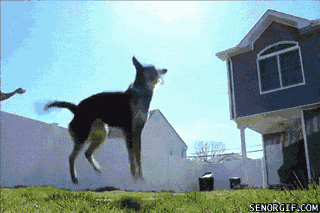
Greater Swiss Mountain Dogs are so cool so why don't you have a look at some facts about them:
#1. "The Greater Swiss Mountain Dog is large, sturdy and muscular."
#2. "The skull is flat and broad, with a slight stop."
#3. "The teeth meet in a scissors bite."
#4. "The nose and lips are black."
#5. "The medium sized, almond shaped eyes vary from hazel to chestnut in color."
#6. "The medium sized ears are triangular in shape, slightly rounded at the tip, hanging close to the head."
#7. "The topline is level."
#8. "The front legs are straight."
#9. "The feed are round and compact."
#10. "The chest is deep and broad."
#11. "The tail is thicker at the base, tapering to a point reaching to the hocks."
#12. "The double coat has a dense outer coat of about 1 - 1 1/4 to 2 inches (3-5 cm.) long. The under coat is thick. The tri-color coat has a black base with rust and white specific markings. Symmetrical markings are prefred by breeders. Rust markings appear in a spot over each eye, on the cheeks and on either side of the chest. White appears as a blaze on the muzzle, on the chest, and on the tip of the tail. There may be a white collar or patches of white on the neck."
#13. "The Greater Swiss Mountain Dog is willing and eager to please."
#14. "They are excellent with children."
#15. "Devoted, sweet and easy-going, generally good with other pets and is not dog aggressive."
#16. "Teach them not to chase."
#17. "Cautious, and protective, of the home."
#18. "The Swissy warms up quickly to welcomed newcomers."
#19. "An admirable, courageous, keen watchdog who will bark if they hear something out of the ordinary."
#20. "They will not be happy confined to kennel life, enjoying their family."
#21. "This giant breed matures slowly in both mind and body, taking anywhere from 2 - 3 years."
#22. "The objective in training this dog is to achieve a pack leader status. It is a natural instinct for a dog to have an order in their pack. When we humans live with dogs, we become their pack. The entire pack cooperates under a single leader. Lines are clearly defined and rules are set. Because a dog communicates his displeasure with growling and eventually biting, all other humans MUST be higher up in the order than the dog. The humans must be the ones making the decisions, not the dogs. That is the only way your relationship with your dog can be a complete success."
#23. "Height: 23.5-28.5 (60-72cm.)"
#24. "Weight: 130-135 pounds (59-61kg.)"
#25. "Prone to bloat, epilepsy, digestive disorders, hip dysplasia and distichiasis (extra eyelashes)."
#26. "They will do okay in an apartment if sufficiently exercised. They prefer cool climates. A small yard is sufficient."
#27. "Moderate exercise is needed, however they do need to be taken on a daily, long walk, where the dog is made to heel beside or behind the person holding the lead, never in front, as instinct tells a dog the leader leads the way, and that leader needs to be the human."
#28. "Life Expectancy: About 10-11 years."
#29. "An easy groom dog. Regular brushing will due. This breed is an average shedder."
#30. "The Greater Swiss Mountain Dog was developed in the Swiss Alps, Switzerland, descending from the Roman Mastiffs, brought to the area more than 2000 years ago. The largest and oldest of the four Sennenhund Breeds, which include the Bernese Mountain Dog, Appenzell Cattle Dog and the Entlebuch Cattle Dog. All four of these dogs have the same colors and markings but are different sizes. Used as draft dogs, guarding and herding livestock and as a farm sentinel. Their popularity as a draft dog led to the nickname, "the poor man's horse." The Greater Swiss Mountain dog may have contributed to the development of the St. Bernard. The breed almost became extinct in the late 1900s as machines and other breeds replaced them in their work. Dr. Albert Heim, who was an expert of the Sennenhund breeds, rediscovered the Greater Swiss Mountain Dog in 1908 while he was judging a dog show, and began to encourage breeders to take interest in them. His efforts resulted in the re-establishment of the breed. The GSMD's were first imported to the USA in 1967, but are still rare even in Switzerland. They were first recognized by the AKC in 1995. The GSMD's talents are tracking, watchdog, guarding, carting, and competitive obedience."
Pic of Swissy from: http://cdn-www.dailypuppy.com/media/dogs/anonymous/coda_swiss.jpg_w450.jpg




Hi Annabel,
ReplyDeleteIs the Swiss Mountain dog the same as the Swiss Bernese Mountain dog or are they just related?
I think they're just related.
ReplyDelete